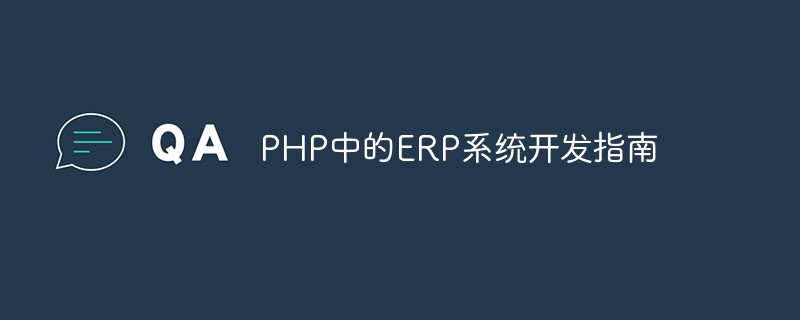 Backend Development
Backend Development PHP Tutorial
PHP Tutorial A guide to secure programming and defending against coding vulnerabilities in PHP
A guide to secure programming and defending against coding vulnerabilities in PHP
GUIDE TO PHP SECURE PROGRAMMING AND DEFENSE CODING VULNERABILITIES
With the rapid development of the Internet, PHP, as a commonly used server-side programming language, is widely used in Web development middle. However, at the same time, Web security issues have also become an important topic in the Internet world. This article will introduce you to PHP secure programming principles and provide some sample code to defend against common coding vulnerabilities.
- Input Validation and Filtering
Input validation is an important step in ensuring that user-submitted data conforms to the expected format. You can use built-in PHP functions likefilter_var()andpreg_match()for verification. For example, if you want to verify an email address, you can use the following code:
$email = $_POST['email'];
if (filter_var($email, FILTER_VALIDATE_EMAIL)) {
// 验证通过
// 继续处理
} else {
// 验证失败
// 给出错误提示
}- Output encoding
Output encoding is an important part of preventing cross-site scripting attacks (XSS). Before outputting user data to the front end, be sure to process it using appropriate encoding functions. For example, use thehtmlspecialchars()function to convert special characters into HTML entities to prevent them from being interpreted as HTML tags by the browser:
$username = $_GET['username']; echo '欢迎,' . htmlspecialchars($username);
- Prevent SQL injection
To prevent SQL injection attacks, parameterized queries or prepared statements should be used. The following is a sample code using prepared statements:
$stmt = $pdo->prepare('SELECT * FROM users WHERE username = :username');
$stmt->execute([':username' => $username]);
$result = $stmt->fetch(PDO::FETCH_ASSOC);- File upload and processing
When receiving files uploaded by users, be sure to perform necessary security checks. First, verify the file type and size and make sure only trusted file types are accepted. Then, set a secure storage path for the uploaded file and rename it to prevent directory traversal attacks. The following is a sample code for file upload:
$allowedTypes = ['image/jpeg', 'image/png'];
$maxSize = 1024 * 1024; // 1 MB
$uploadDir = 'uploads/';
$file = $_FILES['file'];
if (in_array($file['type'], $allowedTypes) && $file['size'] <= $maxSize) {
$filename = uniqid() . '_' . $file['name'];
move_uploaded_file($file['tmp_name'], $uploadDir . $filename);
// 文件上传成功
} else {
// 文件上传失败
}- Session Management and Security
Protecting user sessions is a vital part of web applications. To prevent session hijacking and forgery attacks, you should enable the security settings of Session ID and set the properties of Session Cookie toHttpOnlyandSecure. The following is an example of setting a Session Cookie:
session_set_cookie_params([
'lifetime' => 86400, // 一天
'path' => '/',
'domain' => $_SERVER['HTTP_HOST'],
'secure' => true, // 仅通过HTTPS传输
'httponly' => true // 仅限HTTP访问,无法被JavaScript访问
]);
session_start();- Logging and Error Handling
Logging application logs is a useful way to monitor potential security issues and abnormal situation. Use PHP's built-in logging function to record error and exception information to a log file instead of outputting it directly to the user. The following is a basic logging sample code:
function log_error($message) {
error_log($message, 3, 'error.log');
}
try {
// 代码块
} catch (Exception $e) {
log_error($e->getMessage());
// 错误处理逻辑
}To sum up, PHP security programming and defense against coding vulnerabilities require input validation and filtering, output encoding, prevention of SQL injection, file upload and processing, session Start with management and security, logging and error handling. By learning and practicing these secure programming principles, you can improve the security of your web applications and reduce potential risks and vulnerabilities.
The above is a brief introduction and sample code of PHP security programming and defense coding vulnerabilities in this article. I hope it will be helpful to your PHP development work. During the programming process, always keep in mind that security is an important responsibility, minimize all security risks, and ensure the security of user data and systems.
The above is the detailed content of A guide to secure programming and defending against coding vulnerabilities in PHP. For more information, please follow other related articles on the PHP Chinese website!
 在Go语言中使用Elastic Stack:完整指南Jun 17, 2023 am 10:42 AM
在Go语言中使用Elastic Stack:完整指南Jun 17, 2023 am 10:42 AM在Go语言中使用ElasticStack:完整指南ElasticStack是一个开源工具集,它为搜索、分析和可视化大量数据提供了强大的支持。该工具集由四个主要组件组成:Elasticsearch、Logstash、Kibana和Beats。其中,Elasticsearch是一个分布式的搜索和分析引擎,能够快速地执行搜索、分析和聚合操作。Logstash是
 在Go语言中使用AWS SDK:完整指南Jun 17, 2023 am 09:40 AM
在Go语言中使用AWS SDK:完整指南Jun 17, 2023 am 09:40 AMAWS(AmazonWebServices)是一家全球领先的云计算提供商,为企业和个人提供各种云计算服务。随着云计算技术的发展,越来越多的开发者开始使用AWS来进行开发、测试和部署他们的应用程序。Go语言是一门非常流行的编程语言,尤其适合构建高性能和可扩展的云原生应用程序。AWS提供了适用于Go语言的SDK(SoftwareDevelopmentKi
 PHP中的安全审计指南Jun 11, 2023 pm 02:59 PM
PHP中的安全审计指南Jun 11, 2023 pm 02:59 PM随着Web应用程序的日益普及,安全审计也变得越来越重要。PHP是一种广泛使用的编程语言,也是很多Web应用程序的基础。本文将介绍PHP中的安全审计指南,以帮助开发人员编写更加安全的Web应用程序。输入验证输入验证是Web应用程序中最基本的安全特性之一。虽然PHP提供了许多内置函数来对输入进行过滤和验证,但这些函数并不能完全保证输入的安全性。因此,开发人员需要
 在Go语言中使用AWS S3:完整指南Jun 17, 2023 am 08:21 AM
在Go语言中使用AWS S3:完整指南Jun 17, 2023 am 08:21 AM近年来,随着云计算技术的发展,许多企业开始转向使用云存储服务来存储和管理自己的数据。其中,AWSS3(AmazonWebServicesSimpleStorageService)是一种备受欢迎的选择。作为AWS的核心服务之一,S3提供了高可用性、高性能、可扩展和安全的存储服务。在这篇文章中,我们将深入探讨如何在Go语言中使用AWSS3。安装AW
 PHP中的ERP系统开发指南May 21, 2023 am 08:22 AM
PHP中的ERP系统开发指南May 21, 2023 am 08:22 AM随着现代企业的发展,ERP系统的重要性也越来越凸显出来。ERP系统可以帮助企业集成和管理计划、客户关系、供应链、人力资源等方面的数据和业务流程。PHP作为一种流行的编程语言,也可以用于开发ERP系统。在本文中,我们将分享一些PHP中的ERP系统开发指南。确定ERP系统的需求在开始开发ERP系统之前,您需要确定自己的ERP系统所需要的功能。根据你的企业的运营方
![如何使用 wmic 快速列出所有 Windows 进程 [教程]](https://img.php.cn/upload/article/000/887/227/168569000461539.jpg) 如何使用 wmic 快速列出所有 Windows 进程 [教程]Jun 02, 2023 pm 03:13 PM
如何使用 wmic 快速列出所有 Windows 进程 [教程]Jun 02, 2023 pm 03:13 PM当您在处理各种重要项目并且性能是关键字时,必须准确了解后台运行的进程。特别是如果上述一个或多个过程影响您当前的工作,或者您可以只使用额外的果汁。准确地找出您的设备仍在后台运行的内容非常容易。您可以使用wmic工具在几秒钟内获得所需的所有信息。怎么样,你问?我们将在本文中向您展示这一点,因此您可以方便地获得这些信息以供将来参考。如何使用wmic了解后台进程?实际上,您可以在命令提示符窗口中输入许多有用的命令,前提是您以管理员权限打开它,这些命令可以提供宝贵的信息。了解后台进程以及收集系统信息(BI
 PHP中的音频操作指南May 20, 2023 pm 09:42 PM
PHP中的音频操作指南May 20, 2023 pm 09:42 PMPHP作为一种广泛使用的服务器端语言,在许多Web应用程序中扮演着重要的角色。音频处理是一个很常见的需求,例如音乐网站和音频产品销售网站等。在本文中,将为读者介绍如何在PHP中操作音频文件。一、了解音频格式在PHP中操作音频文件前,需要先了解音频文件格式。常见的音频格式有MP3、WAV、OGG、FLAC等。不同的格式有不同的音频编码算法和数据格式。例如,MP
 在Go语言中使用AWS IAM:完整指南Jun 17, 2023 pm 03:39 PM
在Go语言中使用AWS IAM:完整指南Jun 17, 2023 pm 03:39 PMAWS(AmazonWebServices)作为云计算业界的领头羊,提供了方便而强大的云计算服务,使得企业可以轻松地构建和管理自己的IT基础设施,并获得更好的可扩展性、灵活性和低成本。而IAM(IdentityandAccessManagement)是AWS中的重要服务之一,负责管理用户(包括人员、应用、服务等)的身份和访问权限,保障AWS资源的安


Hot AI Tools

Undresser.AI Undress
AI-powered app for creating realistic nude photos

AI Clothes Remover
Online AI tool for removing clothes from photos.

Undress AI Tool
Undress images for free

Clothoff.io
AI clothes remover

AI Hentai Generator
Generate AI Hentai for free.

Hot Article

Hot Tools

SublimeText3 Mac version
God-level code editing software (SublimeText3)

mPDF
mPDF is a PHP library that can generate PDF files from UTF-8 encoded HTML. The original author, Ian Back, wrote mPDF to output PDF files "on the fly" from his website and handle different languages. It is slower than original scripts like HTML2FPDF and produces larger files when using Unicode fonts, but supports CSS styles etc. and has a lot of enhancements. Supports almost all languages, including RTL (Arabic and Hebrew) and CJK (Chinese, Japanese and Korean). Supports nested block-level elements (such as P, DIV),

SublimeText3 Chinese version
Chinese version, very easy to use

EditPlus Chinese cracked version
Small size, syntax highlighting, does not support code prompt function

VSCode Windows 64-bit Download
A free and powerful IDE editor launched by Microsoft





